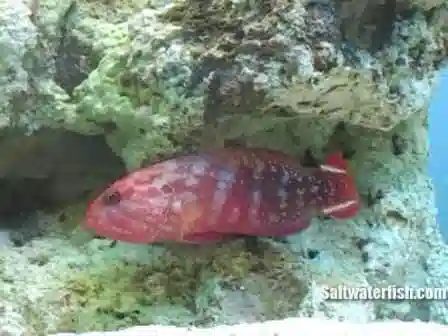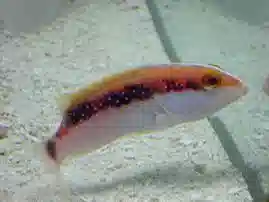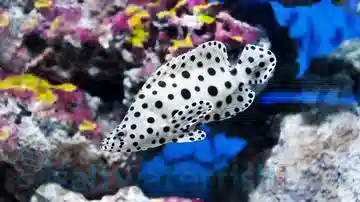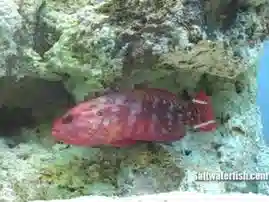Red V Tail Grouper
Cephalopholis urodelus
(1 Reviews)

Red V Tail Grouper
Cephalopholis urodelus
(1 Reviews)
{{ item.name }}
Size: {{ item.extra_field_3 }}
${{ getFormattedPrice(item.saleprice) }} ${{ getFormattedPrice(item.price) }}
To join the waiting list, click here
Free Shipping
With
$199.00
or more in Marine Life.
More details...
Red V Tail Grouper Care Facts
| Care Level: | Easy |
|---|---|
| Temperament: | Aggressive |
| Diet: | Carnivore |
| Reef Safe: | No |
| Minimum Tank Size: | 180 gallons |
| Max Size: | 11 inches |
Red V Tail Grouper (Cephalopholis urodelus): A Practical Guide for Saltwater Aquarium Enthusiasts
Thie Red V Tail Grouper, scientifically known as Cephalopholis urodelus is a popular fish for many aquaculture enthusiasts. We aim to provide you with essential information for your saltwater marine aquarium. We'll cover crucial aspects, including the Red V Tail Grouper's natural habitat, reef compatibility, size, lifespan, dietary requirements in captivity, aquaculture status, compatibility with other marine species, sexual dimorphism, juvenile to adult coloration changes, temperament, detailed tank requirements, and precise water conditions. Additionally, we'll list alternative common names for the Red V Tail Grouper and explain why choosing Saltwaterfish.com for your purchase is a practical choice.
Habitat and Natural Range of the Red V Tail Grouper
The Red V Tail Grouper, Cephalopholis urodelus, is native to the warm tropical waters of the Western Atlantic Ocean. It is commonly found in rocky crevices, caves, and coral formations in depths ranging from 15 to 100 feet (4.5 to 30 meters). Understanding its natural habitat is crucial for creating a suitable environment in your aquarium.
Reef Compatibility of the Red V Tail Grouper
The Red V Tail Grouper is generally considered not reef-safe. These groupers are opportunistic predators and may prey on smaller fish and ornamental invertebrates within a reef environment. If you intend to keep one in a reef tank, exercise caution and ensure ample hiding spots for potential prey.
Size and Lifespan of the Red V Tail Grouper
This species can attain a maximum size of approximately 12 inches (30 centimeters) in captivity. With proper care, Red V Tail Groupers can live for up to 10 years or more, making them a long-term commitment for aquarium enthusiasts.
The Red V Tail Grouper's Dietary Needs in Captivity
Feeding the Red V Tail Grouper in captivity is relatively straightforward, as they are carnivorous predators. Their diet should primarily consist of:
- Protein-based foods: Offer high-quality marine-based pellets, flakes, and frozen foods, such as shrimp, krill, and squid.
- Live or frozen prey: Occasionally, providing live or frozen foods like small fish, shrimp, and marine worms can help meet their nutritional needs.
- Variety: Ensuring a diverse diet with a mix of protein sources is essential for their health.
Aquaculture and Availability of the Red V Tail Grouper
As of now, Red V Tail Groupers are not available through aquaculture. However, they are frequently accessible in the aquarium trade, making them a viable choice for hobbyists. Please choose responsible suppliers.
Compatibility of the Red V Tail Grouper with Other Fish and Invertebrates
Red V Tail Groupers can be territorial and may exhibit aggressive behaviors, especially as they grow larger. When selecting tankmates, consider their size, compatibility, and potential territorial nature. Here are five compatible tankmates for your Red V Tail Grouper:
- Triggerfish (Balistidae family): These robust fish can coexist with Red V Tail Groupers as they are similar in size and temperament.
- Lionfish (Pterois spp.): Larger lionfish species can be suitable tankmates, provided they are not small enough to be considered prey.
- Large angelfish (Pomacanthidae family): Select larger angelfish species that can hold their ground against the grouper.
- Moray eels (Muraenidae family): These eels, when of a similar size, can cohabitate without significant issues.
- Surgeonfish (Acanthuridae family): Larger surgeonfish species can be compatible tankmates in a well-sized aquarium.
Sexual Dimorphism of the Red V Tail Grouper
The Red V Tail Grouper exhibits sexual dimorphism, meaning there are distinct differences in appearance between males and females. Males typically display more vibrant coloration and may have slightly different fin shapes.
Juvenile to Adult Coloration Changes
Juvenile Red V Tail Groupers often exhibit brighter and more vivid colors than adults. As they mature, their coloration may become slightly subdued, but they maintain their distinctive appearance, including the vibrant red V-shaped tail that gives them their name.
Temperament of the Red V Tail Grouper
Red V Tail Groupers are known for their territorial and somewhat aggressive temperament, especially towards smaller or similarly sized tankmates. They may establish dominance within the aquarium and defend their chosen territory.
Tank Requirements of the Red V Tail Grouper
To ensure the well-being of your Red V Tail Grouper, consider the following tank requirements:
- Minimum Aquarium Size: Due to their potential size and territorial nature, it is advisable to house a Red V Tail Grouper in a tank with a minimum capacity of 75 gallons (284 liters). This provides ample swimming space and opportunities to establish territories.
- Aquascaping: Create a habitat that mimics their natural rocky environment, offering hiding spots, caves, and crevices. This helps alleviate territorial disputes by providing separation.
Detailed Water Needs for the Red V Tail Grouper
- pH: Maintain a stable pH level within the range of 8.1 to 8.4 to provide a suitable alkaline environment.
- Salinity: Keep the salinity level at 1.022 to 1.025 for optimal osmoregulation.
- Water Temperature: Maintain a consistent water temperature between 76°F to 82°F (24°C to 28°C) to ensure their comfort and vitality.
- Water Flow: Provide moderate water flow to replicate their natural habitat without causing excessive turbulence.
Other Common Names of the Red V Tail Grouper
Apart from the Red V Tail Grouper, this species is known by other common names, including the Red Tail Grouper, Red-Backed Grouper, and Red V-Tailed Rockcod.
Why People Should Buy the Red V Tail Grouper from Saltwaterfish.com
Purchasing your Red V Tail Grouper from Saltwaterfish.com offers several advantages:
- Quality Assurance: Saltwaterfish.com is dedicated to delivering healthy and vibrant Red V Tail Groupers. Each fish undergoes careful selection to guarantee top-quality specimens.
- Expert Support: Our team of marine experts is readily available to offer guidance and assistance, ensuring your Red V Tail Grouper thrives in your aquarium.
- Convenience: We provide a seamless online selection process and reliable home delivery, making it convenient for you to acquire your Red V Tail Grouper.
- Sustainability: By choosing Saltwaterfish.com, you support responsible collection practices and marine conservation, contributing to the well-being of marine ecosystems.
In conclusion, the Red V Tail Grouper (Cephalopholis urodelus) is a practical choice for saltwater aquarium enthusiasts who appreciate its vibrant appearance and are prepared to cater to its territorial nature. Saltwaterfish.com offers a reliable source for obtaining healthy and vibrant Red V Tail Groupers, backed by a commitment to ethical collection practices and marine conservation. Add a touch of vivid elegance to your aquarium with the Red V Tail Grouper.
An awesome little beautiful Red V Tail Grouper who peacefully explores my large reef tank's caves. Almost always visible and active.
Reviewed by: Rick Ellison on Sept. 12, 2021












